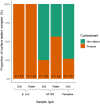Impact of sanitation system types on residential and environmental presence of human waste and parasites in Alabama
- PMID: 40646638
- PMCID: PMC12247418
- DOI: 10.1186/s40249-025-01334-4
Impact of sanitation system types on residential and environmental presence of human waste and parasites in Alabama
Abstract
Lowndes County is a predominantly Black rural county in Alabama, in the United States, which has a historical and current legacy of racial discrimination, creating inequitable infrastructure access and adverse health impacts. Over 80% rely on on-site sanitation infrastructure and most are failing. A community assessment of exposure to untreated sewage was conducted using samples from residential drinking water, surface swabs, and soil combined with environmental water and soil samples using culture-based and quantitative polymerase chain reaction (qPCR) methods. Testing varied slightly across samples, due to difficulty of access or availability. Of 43 households, 68% and 55% of houses had detectable presence of human fecal matter indicator in their soils and on their doorsteps, respectively, and 0% had detectable amounts of culturable Escherichia coli in their drinking water. Of 40 houses sampled, 88% tested positive for E. coli in soil samples. Of 39 residences, 31% had positive presence of environmental and zoonotic parasites in soil, but none for Necator americanus, Cryptosporidium species, or Giardia intestinalis. Of the 18 sampled environmental surface waters, 100% tested positive for culturable E. coli, 50% had detectable human fecal matter indicator present, and 27% tested positive for anthropogenic parasites. This work sheds light that there is presence of culturable E. coli, human fecal matter, and anthropogenic parasites in residential soil samples of all sanitation types (municipal, septic tank, and straight piping) and in environmental surface waters throughout the sampled areas. Our findings support the narrative that sanitation infrastructure of all types in Lowndes County, Alabama are compromised and highlights residential and environmental exposure to raw wastewater.
Keywords: Exposure; Infrastructure; Parasite; Sanitation; Waste.
© 2025. The Author(s).
Conflict of interest statement
Declarations. Ethics approval and consent to participate: Samples from residents were only taken if residents consented to participate through a Duke IRB approved protocol (IRB #2017-1391). Consent for publication: Not applicable. Competing interests: The authors declare that they have no competing interests.
Figures









Similar articles
-
Interventions to improve water, sanitation, and hygiene for preventing soil-transmitted helminth infection.Cochrane Database Syst Rev. 2022 Jun 21;6(6):CD012199. doi: 10.1002/14651858.CD012199.pub2. Cochrane Database Syst Rev. 2022. PMID: 35726112 Free PMC article.
-
Signs and symptoms to determine if a patient presenting in primary care or hospital outpatient settings has COVID-19.Cochrane Database Syst Rev. 2022 May 20;5(5):CD013665. doi: 10.1002/14651858.CD013665.pub3. Cochrane Database Syst Rev. 2022. PMID: 35593186 Free PMC article.
-
The effect of sample site and collection procedure on identification of SARS-CoV-2 infection.Cochrane Database Syst Rev. 2024 Dec 16;12(12):CD014780. doi: 10.1002/14651858.CD014780. Cochrane Database Syst Rev. 2024. PMID: 39679851 Free PMC article.
-
Interventions to improve sanitation for preventing diarrhoea.Cochrane Database Syst Rev. 2023 Jan 25;1(1):CD013328. doi: 10.1002/14651858.CD013328.pub2. Cochrane Database Syst Rev. 2023. PMID: 36697370 Free PMC article.
-
Slum upgrading strategies involving physical environment and infrastructure interventions and their effects on health and socio-economic outcomes.Cochrane Database Syst Rev. 2013 Jan 31;(1):CD010067. doi: 10.1002/14651858.CD010067.pub2. Cochrane Database Syst Rev. 2013. PMID: 23440845
References
-
- World Health Organization, United Nations Children’s Fund. Progress on household drinking water, sanitation and hygiene 2000–2020. Geneva: World Health Organization; 2021.
-
- ASCE. Failure to act: the economic impact of current investment trends in water and wastewater infrastructure. Virginia: ASCE; 2011.
-
- U.S. EPA. Septic systems overview. Washington, DC: U.S. EPA.; 2015.
-
- Gasteyer SP, Lai J, Tucker B, Carrera J, Moss J. BASICS INEQUALITY: race and access to complete plumbing facilities in the United States. Bois Rev Soc Sci Res Race. 2016;13(2):305–25. 10.1017/S1742058X16000242.
-
- Gasteyer SP, Vaswani R. Without the basics analyzing the availability of water and sanitation services in the United States rural community assistance partnership in the 21st century still living. New York: Polity Press; 2004. p. 1–208.
MeSH terms
Substances
LinkOut - more resources
Full Text Sources

